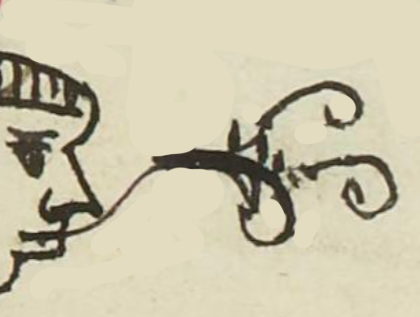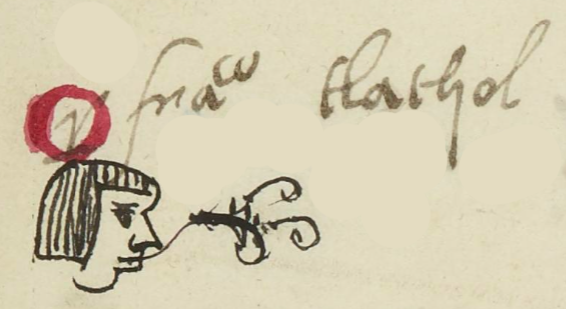Tlatol (MH787r)
This black-line drawing of the simplex glyph for the personal name Tlatol (or Tlahtol, with the glottal stop, “Word,” attested here as a man’s name) shows a group of speech scrolls in front of the face of the tribute payer, but not directly emerging from his mouth. The three volutes all curl under at the ends.
Stephanie Wood
Speech scrolls that come out of a human mouth (also, for instance, from an eagle's beak) can represent a range of vocabulary, including: tlatolli (word), itoa (to speak), tzatzi (to announce), motenehua (aforementioned), nahuatl (language, or a pleasant sound), chalani (to speak a lot), and cuica (to sing), among others.
It is interesting that glyphs for tlatolli are typically represented as oral rather than written (whether alphabetic or hieroglyphic), although there are a small number of scrolls shown as written or painted on paper. Oral communication was paramount in Nahua culture.
Stephanie Wood
fraco tlathol
Francisco Tlatol
Stephanie Wood
1560
Jeff Haskett-Wood
words, palabras, speak, hablar, speech, volutas, nombres de hombres

tlatol(li), speech, words, https://nahuatl.wired-humanities.org/content/tlatolli
La Palabra
Stephanie Wood
Matrícula de Huexotzinco, folio 787r, World Digital Library, https://www.loc.gov/resource/gdcwdl.wdl_15282/?sp=648&st=image
This manuscript is hosted by the Library of Congress and the World Digital Library; used here with the Creative Commons, “Attribution-NonCommercial-ShareAlike 3.0 License” (CC-BY-NC-SAq 3.0).






